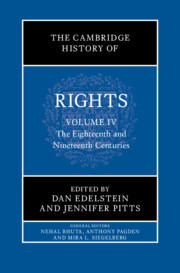Book contents
- the cambridge history of rights
- The Cambridge History of Rights
- The Cambridge History of Rights
- Copyright page
- Contents
- Figures
- Contributors to Volume IV
- General Introduction
- A Note on Translations
- Introduction to Volume IV
- Part I A Revolution in Rights?
- Part II Postrevolutionary Rights
- 12 On the Nadir of Natural Rights Theory in Nineteenth-Century Britain
- 13 The 1789 Declaration of the Rights of Man and of the Citizen
- 14 Rights in the Thought of Kant, Fichte, and Hegel
- 15 Rights and Socialism 1750–1880
- 16 Economic Liberalism and Rights in the Nineteenth Century
- 17 Human Rights during the 1848 Revolutions
- Part III Rights and Empires
- Index
- References
17 - Human Rights during the 1848 Revolutions
from Part II - Postrevolutionary Rights
Published online by Cambridge University Press: 22 January 2025
- the cambridge history of rights
- The Cambridge History of Rights
- The Cambridge History of Rights
- Copyright page
- Contents
- Figures
- Contributors to Volume IV
- General Introduction
- A Note on Translations
- Introduction to Volume IV
- Part I A Revolution in Rights?
- Part II Postrevolutionary Rights
- 12 On the Nadir of Natural Rights Theory in Nineteenth-Century Britain
- 13 The 1789 Declaration of the Rights of Man and of the Citizen
- 14 Rights in the Thought of Kant, Fichte, and Hegel
- 15 Rights and Socialism 1750–1880
- 16 Economic Liberalism and Rights in the Nineteenth Century
- 17 Human Rights during the 1848 Revolutions
- Part III Rights and Empires
- Index
- References
Summary
This chapter argues that the 1848 Revolutions can profitably be understood through the prism of arguments over rights. It highlights a series of contests between those who championed a “thin” conception of individual civil and political rights and those who defended a variety of “thicker” understandings: whether of rights as belonging to collectives, especially national minorities; as protecting cultural, linguistic, or gender identities and differences; or as demands for extensive state action to challenge economic domination of workers by landowners and capitalists. The offer of individual rights under a “thinner” constitutional order in the Habsburg monarchy was insufficient to address conflicts between the dominant Magyar nation and the claims of the regime’s other national groups; at the same time, these conflicts generated nuanced efforts to theorize individual and collective rights by figures such as József Eötvös. Ostensibly “thin” demands for individual equality under the law proved unable to protect individuals – particularly emancipated slaves, peasants, laborers, and women – from domination deep-seated in existing social structures.
- Type
- Chapter
- Information
- The Cambridge History of Rights , pp. 407 - 434Publisher: Cambridge University PressPrint publication year: 2024

